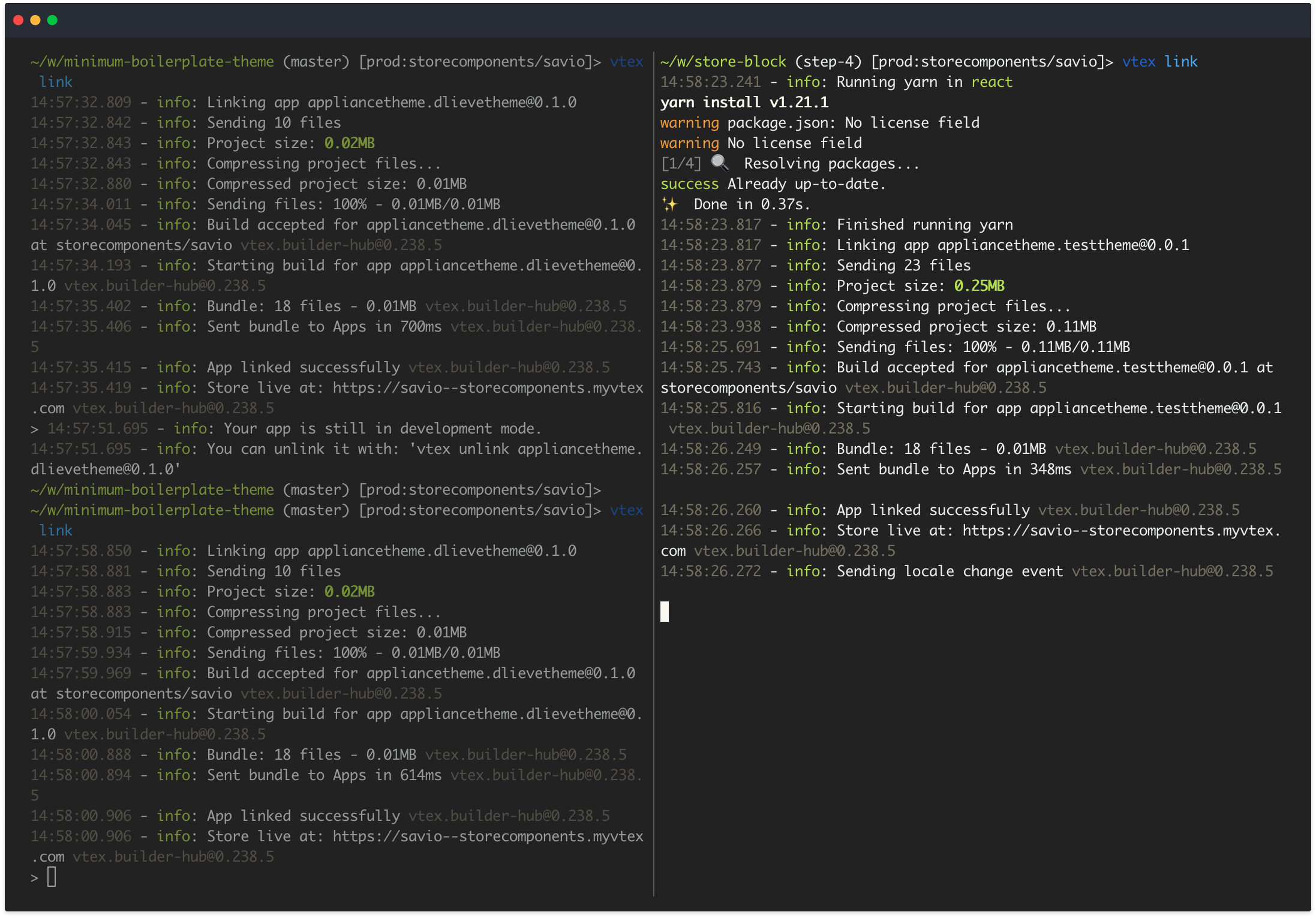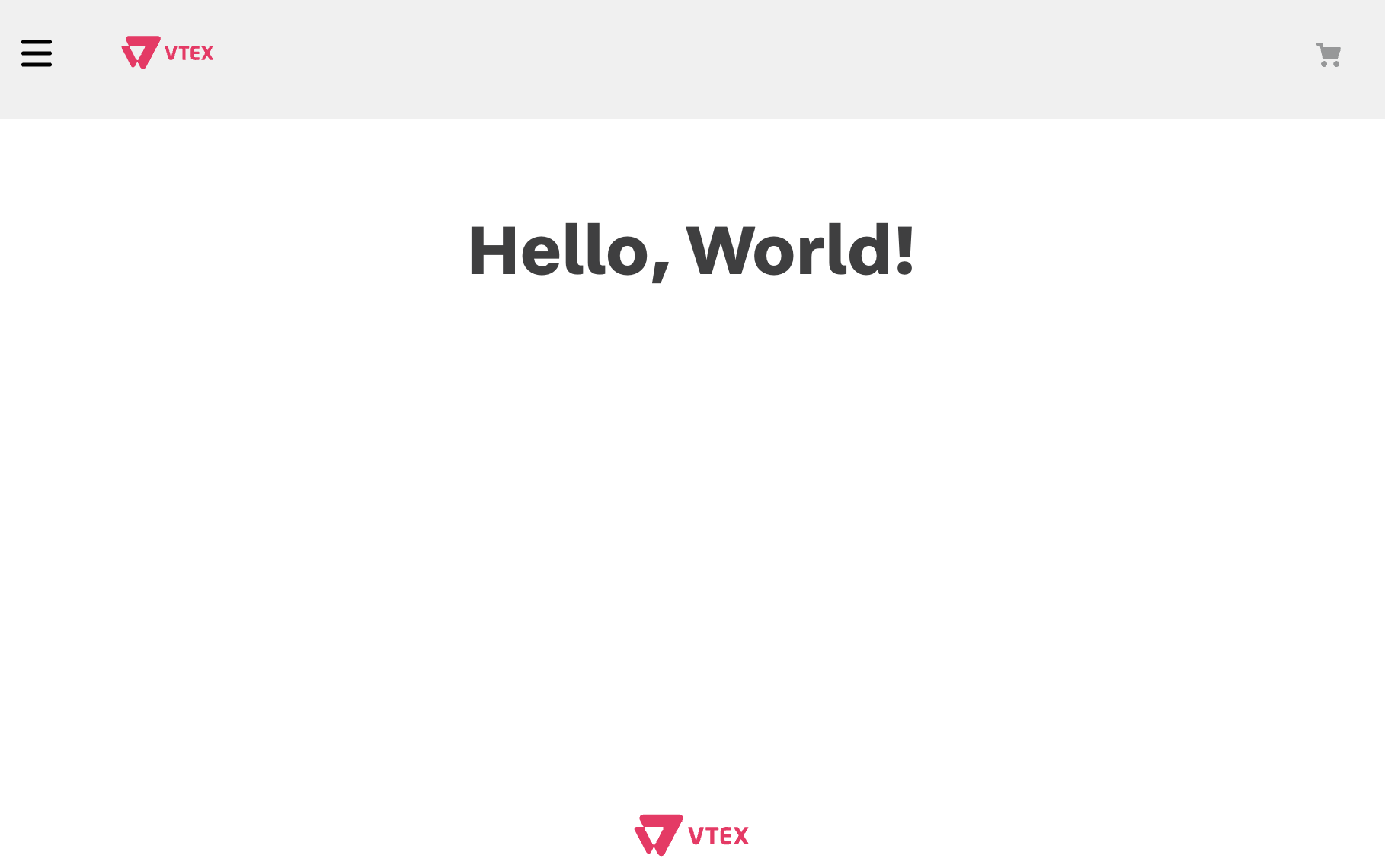3. Declaring a theme block
Learn how to create a new theme block.
With the app template already copied, we will now create a new theme block. Follow the instructions below to create the new theme block.
Understanding interfaces
An interface describes the shape of an object, including its properties and data types. This is crucial for ensuring type safety and preventing potential bugs.
In VTEX Store Framework, interfaces are used to link theme blocks to their corresponding React components. This way, interfaces provide a set of rules that dictate the behavior of theme blocks when rendering their React components and the available properties and methods.
For each theme block exported by your app, you should define a corresponding interface that defines the props available to the React component.
The following table shows some possible keys that could be added to the block interface, as well as their respective descriptions:
| Key | Description |
|---|---|
component | Name of the React component that the theme block will render. |
allowed | List of other theme blocks that help build the desired React component. When declared, these blocks can be included as children to the block you developed in the Store Theme app. |
composition | Defines the rendering position of the children of the block that you are developing. Remember that when defining the composition key, you don't control the position of the block it defines but the position of the children of that block. Possible values for this key are blocks (the child blocks have a specific position in the interface based on the React component on which they are based) or children (the position of the child blocks depends exclusively on how they are declared in the theme). If no value is defined for the composition key, the platform default is blocks. |
device | Defines whether your theme block is designed for mobile or desktop devices. Possible values are mobile and desktop. |
required | List of theme blocks that must be rendered in the interface to support the block rendering you are developing. |
around | List of theme blocks that must be rendered in the interface around your new block for it to work correctly. |
before | List of theme blocks that must be rendered in the interface before your block (above it) for it to work correctly. For example: header. |
after | List of theme blocks that must be rendered in the interface after your block (below it) for it to work correctly. For example: footer. |
preview | Defines the behavior of the page while the block is loading. |
render | Defines the block rendering type. Possible values are lazy (the block is only rendered when a user interacts with it), server (the block is rendered from the server side), or client (the block is rendered from the client side. |
The only mandatory key that needs to be declared in a block interface is component. You have to declare the other ones based on the desired scenario for your new theme block.
Step 1 - Declaring an interface
To add new custom blocks to your storefront, you need to declare their interfaces in the interfaces.json file of your Store Theme app.
The
interfaces.jsonfile is used by thestoreBuilder during the website building process.
For this example, we will create an interface for a basic block called hello-world. This block will render the React component defined in HelloWorld.tsx.
When following these steps, remember to replace the values with the ones that correspond to the actual scenario of your app based on the React component you are importing.
- Open your app's code (previously called
react-app-template) in the code editor. - In the
reactfolder, create a new TypeScript file with the name of the desired React component. Following our example, we would haveHelloWorld.tsx. - In the newly created file, add the sample code provided below:
_10import React from 'react'_10_10const HelloWorld = () => <div>Hello, World!</div>_10_10export default HelloWorld
Read the React documentation and Developing custom storefront components documentation to better understand how React components work.
- Create a new folder called
storein the first level of your app folders. - In the
storefolder, add a new file calledinterfaces.json. - Declare the block interface in the
interfaces.jsonfile. For example:
_10{_10 "hello-world": {_10 "component": "HelloWorld"_10 }_10}
Note that in the above structure, the first definition given by the interface is the name of your new theme block (hello-world). Within it, we declare an object containing the interface keys previously described.
In our example, we only used the component key to link thehello-world block to the React component that it will render (HelloWorld). Note that the value of the component key is HelloWorld — the file name that was previously created for the React component (react/HelloWorld.tsx).
To learn more about structuring the
interfaces.jsonfile, check the code of native Store Framework apps, such as Search Result and Header. Remember that how we declare an interface depends directly on the behavior we want for the new block. That is why, as we study different apps and blocks, we understand more the possibilities for interfaces.
After saving your code changes, any user who installs your app will be ready to implement the new block.
Note that, if the app under development exports more than one theme block for rendering the React component, all the interfaces of these blocks must also be declared in the interfaces.json file, according to the above format.
Declaring device-specific interfaces
You may want your app to export different blocks for rendering different components based on the store's breakpoint, that is, based on the device accessing it.
To do this, you have to create different blocks for each possible device and create interfaces for each one.
For example, you are developing the hello-world block and want to create mobile and desktop versions. You will have to create the HelloWorld,HelloWorldMobile, and HelloWorldDesktop components, and define interfaces for each, such as hello-world, hello-world.mobile, and hello-world.desktop.
The interface of the parent block, hello-world, has to contain only the component and allowed keys, with the allowed key declaring the hello-world.mobile and hello-world.desktop blocks.
The interfaces for the mobile and desktop blocks, in turn, have to declare the desired keys (e.g., device) to define the behavior of each block according to the device for which they were designed.
App examples that use different React components for different devices are Header and Footer.
Step 2 - Using your new theme block
We will now implement the new block you created in the Store Theme app.
If the VTEX account you are working on has the Store Theme app for Store Framework installed, follow the instructions below from step 2. If your account does not yet have the Store Theme app installed, follow the instructions from step 1:
- Read carefully step 3 in the Building stores with Store Framework section and follow the steps detailed in the article. Once you are done, you will have implemented the standard theme for Store Framework and will be ready to test your new block.
- Open the Store Theme app folder in your local files using the code editor of your choice.
- In the Store Theme
manifest.jsonfile, add the app you are developing as a dependency independencies. For example:
_10"dependencies": {_10+ "{accountName}.{appName}": "{appVersion}",_10 "vtex.store": "2.x",_10 "vtex.store-header": "2.x",_10 "vtex.product-summary": "2.x",_10 "vtex.store-footer": "2.x",_10 "vtex.store-components": "3.x",_10 ..._10}
- Add the new theme block (
hello-worldin our example) to one of the templates. For this walkthrough, we will add thehello-worldblock to the store's home page, in thestore.hometemplate:
_10{_10 "store.home": { _10 "blocks": [_10+ "hello-world"_10 ]_10 },_10 ..._10}
- Link the store's theme to the VTEX IO platform to verify the results:

- Access your VTEX store using the
{workspaceName}-{accountName}.myvtex.comformat to see your newhello-worldblock being displayed in your development workspace:
